Renewable Energy Policies in Australia
VerifiedAdded on 2020/04/07
|17
|4391
|31
AI Summary
This assignment examines the development and implementation of renewable energy policies in Australia. It delves into various aspects such as carbon pricing, renewable energy targets, feed-in tariff schemes, and stakeholder perceptions. The analysis utilizes relevant case studies, reports from expert panels, and research articles to provide a comprehensive understanding of the current landscape and future directions of renewable energy in Australia.
Contribute Materials
Your contribution can guide someone’s learning journey. Share your
documents today.
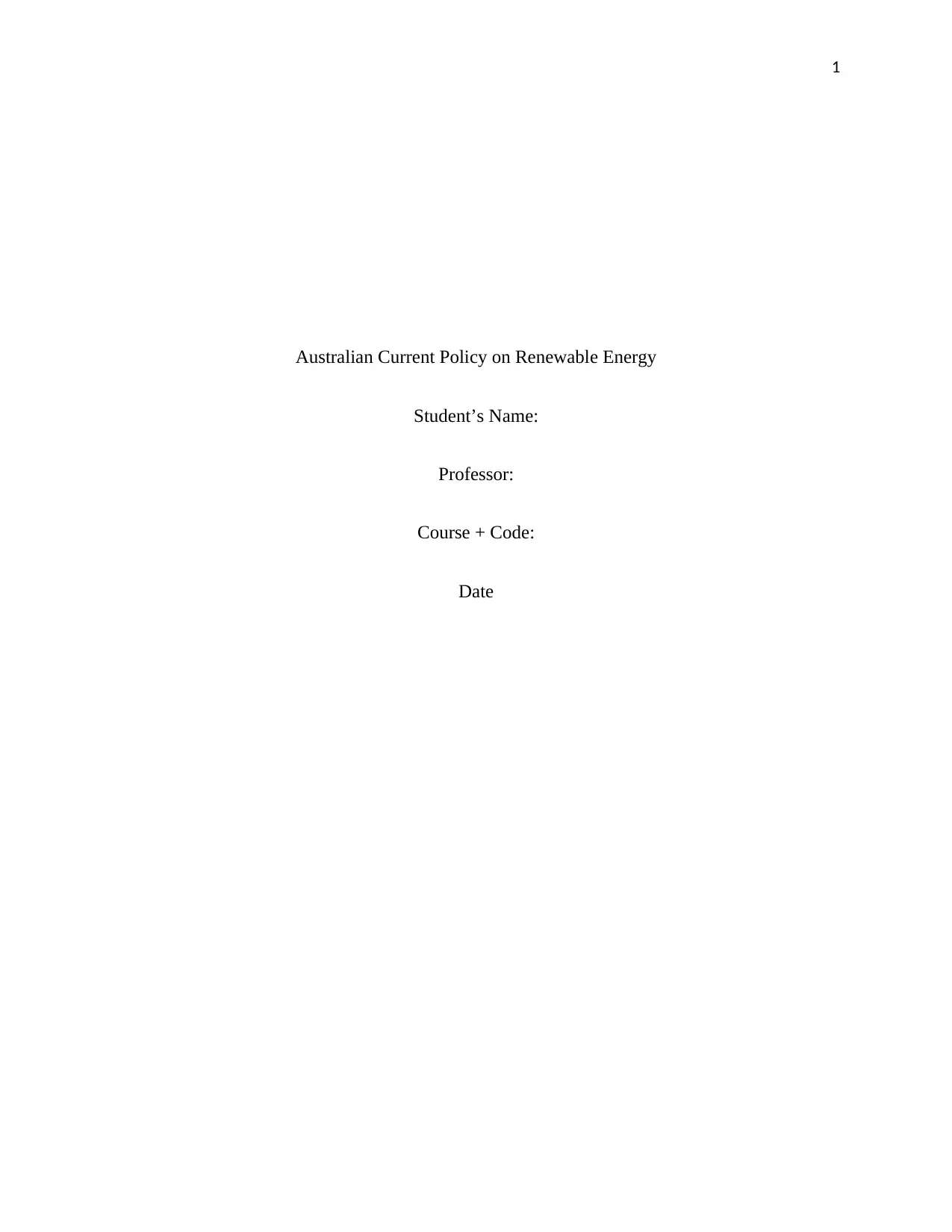
1
Australian Current Policy on Renewable Energy
Student’s Name:
Professor:
Course + Code:
Date
Australian Current Policy on Renewable Energy
Student’s Name:
Professor:
Course + Code:
Date
Secure Best Marks with AI Grader
Need help grading? Try our AI Grader for instant feedback on your assignments.
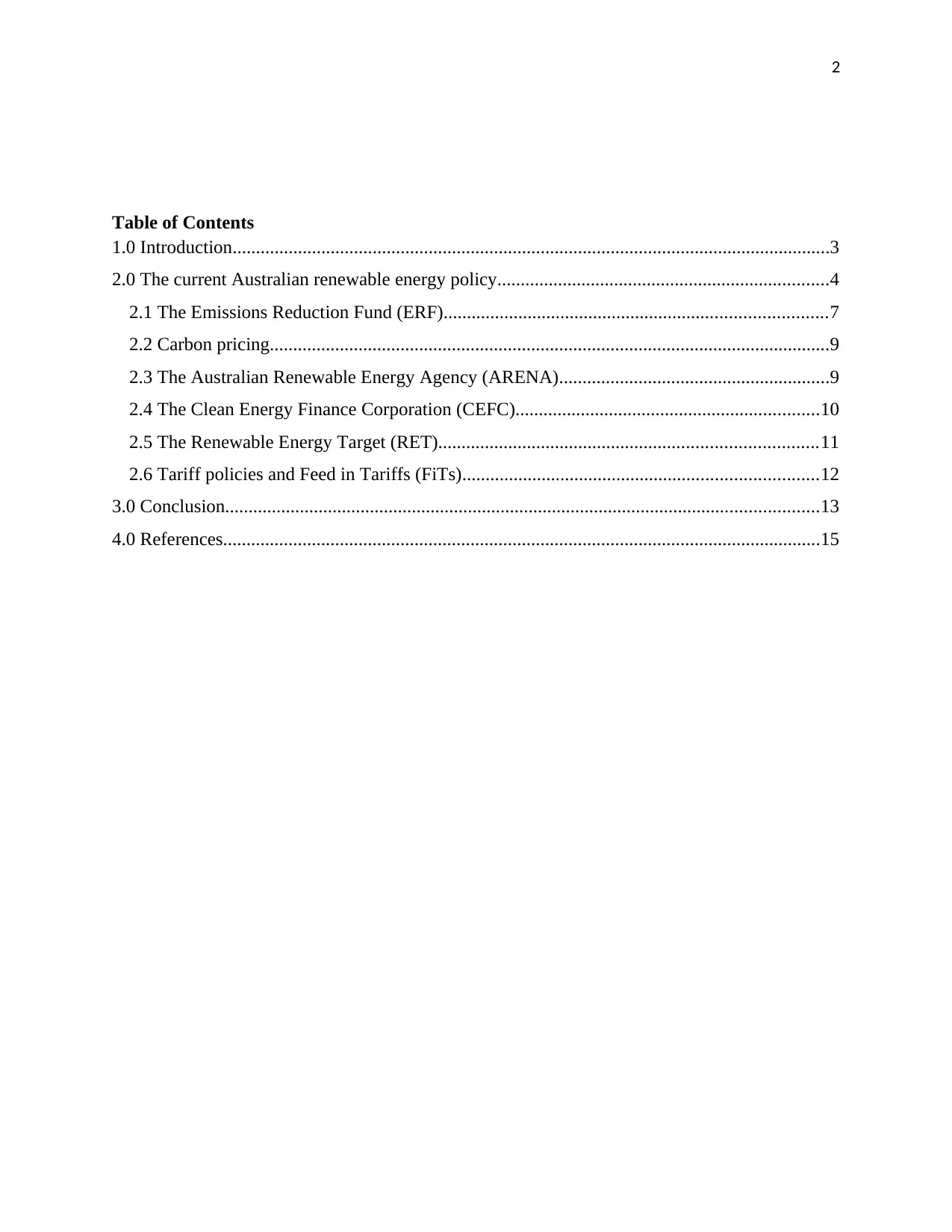
2
Table of Contents
1.0 Introduction................................................................................................................................3
2.0 The current Australian renewable energy policy.......................................................................4
2.1 The Emissions Reduction Fund (ERF)..................................................................................7
2.2 Carbon pricing........................................................................................................................9
2.3 The Australian Renewable Energy Agency (ARENA)..........................................................9
2.4 The Clean Energy Finance Corporation (CEFC).................................................................10
2.5 The Renewable Energy Target (RET).................................................................................11
2.6 Tariff policies and Feed in Tariffs (FiTs)............................................................................12
3.0 Conclusion...............................................................................................................................13
4.0 References................................................................................................................................15
Table of Contents
1.0 Introduction................................................................................................................................3
2.0 The current Australian renewable energy policy.......................................................................4
2.1 The Emissions Reduction Fund (ERF)..................................................................................7
2.2 Carbon pricing........................................................................................................................9
2.3 The Australian Renewable Energy Agency (ARENA)..........................................................9
2.4 The Clean Energy Finance Corporation (CEFC).................................................................10
2.5 The Renewable Energy Target (RET).................................................................................11
2.6 Tariff policies and Feed in Tariffs (FiTs)............................................................................12
3.0 Conclusion...............................................................................................................................13
4.0 References................................................................................................................................15

3
1.0 Introduction
The renewable energy policy plays an increasingly pivotal role as Australia grapples with the
appropriate strategy of climate change as well as increasing penetration in renewables. The
renewable energy policy environment in the recent years has turned out to be highly politicized
and uncertain. The industrial implications are also significant, and the current Australian policy
on renewable energy has been taken through a period of rapid changes. Currently, there is
increasing concern on reduction of various interventions by the government, sectoral efficiency
and having least cost solutions incentivized since the review of the 2013 renewable energy policy
(Buckman & Diesendorf 2010, p.56). The priorities of government and the political parties as
well as polarity in perspectives have been caused by significant policy uncertainty, policy
responses and increased politicization of the climate change. The existing consensus, however,
maintains that there are inefficiencies in the Australian renewables and the energy sector. The
purpose of this paper is to carry out an examination of the key policy measures on renewable
energy as well as their impact on the industry's future.
The single largest sector contribution in Australia is realized from the electric power generation
that produces 33% of the country’s greenhouse gas emissions (GHG emissions). From the year
2012 to 2013, fossil fuels approximately provide 87% of Australia's electricity compared to 13%
realized from the renewable sources (Elliston, Diesendorf & MacGill 2012, p. 89). As a result of
reduced demand for electricity in the National Electricity Market (NEM) of Australia and
variations in the generation mix, there has been approximately a 4% decrease in electric power
emissions from 2012-2013 to 2013-2014. Generation of renewable energy is predominantly
hydro though solar and wind has also been on the rise. Various environmental factors have
mostly caused variation in the hydro generation while a slow-down in the deployment of the
renewables has led to the increased production of the black coal generators. The successive
1.0 Introduction
The renewable energy policy plays an increasingly pivotal role as Australia grapples with the
appropriate strategy of climate change as well as increasing penetration in renewables. The
renewable energy policy environment in the recent years has turned out to be highly politicized
and uncertain. The industrial implications are also significant, and the current Australian policy
on renewable energy has been taken through a period of rapid changes. Currently, there is
increasing concern on reduction of various interventions by the government, sectoral efficiency
and having least cost solutions incentivized since the review of the 2013 renewable energy policy
(Buckman & Diesendorf 2010, p.56). The priorities of government and the political parties as
well as polarity in perspectives have been caused by significant policy uncertainty, policy
responses and increased politicization of the climate change. The existing consensus, however,
maintains that there are inefficiencies in the Australian renewables and the energy sector. The
purpose of this paper is to carry out an examination of the key policy measures on renewable
energy as well as their impact on the industry's future.
The single largest sector contribution in Australia is realized from the electric power generation
that produces 33% of the country’s greenhouse gas emissions (GHG emissions). From the year
2012 to 2013, fossil fuels approximately provide 87% of Australia's electricity compared to 13%
realized from the renewable sources (Elliston, Diesendorf & MacGill 2012, p. 89). As a result of
reduced demand for electricity in the National Electricity Market (NEM) of Australia and
variations in the generation mix, there has been approximately a 4% decrease in electric power
emissions from 2012-2013 to 2013-2014. Generation of renewable energy is predominantly
hydro though solar and wind has also been on the rise. Various environmental factors have
mostly caused variation in the hydro generation while a slow-down in the deployment of the
renewables has led to the increased production of the black coal generators. The successive
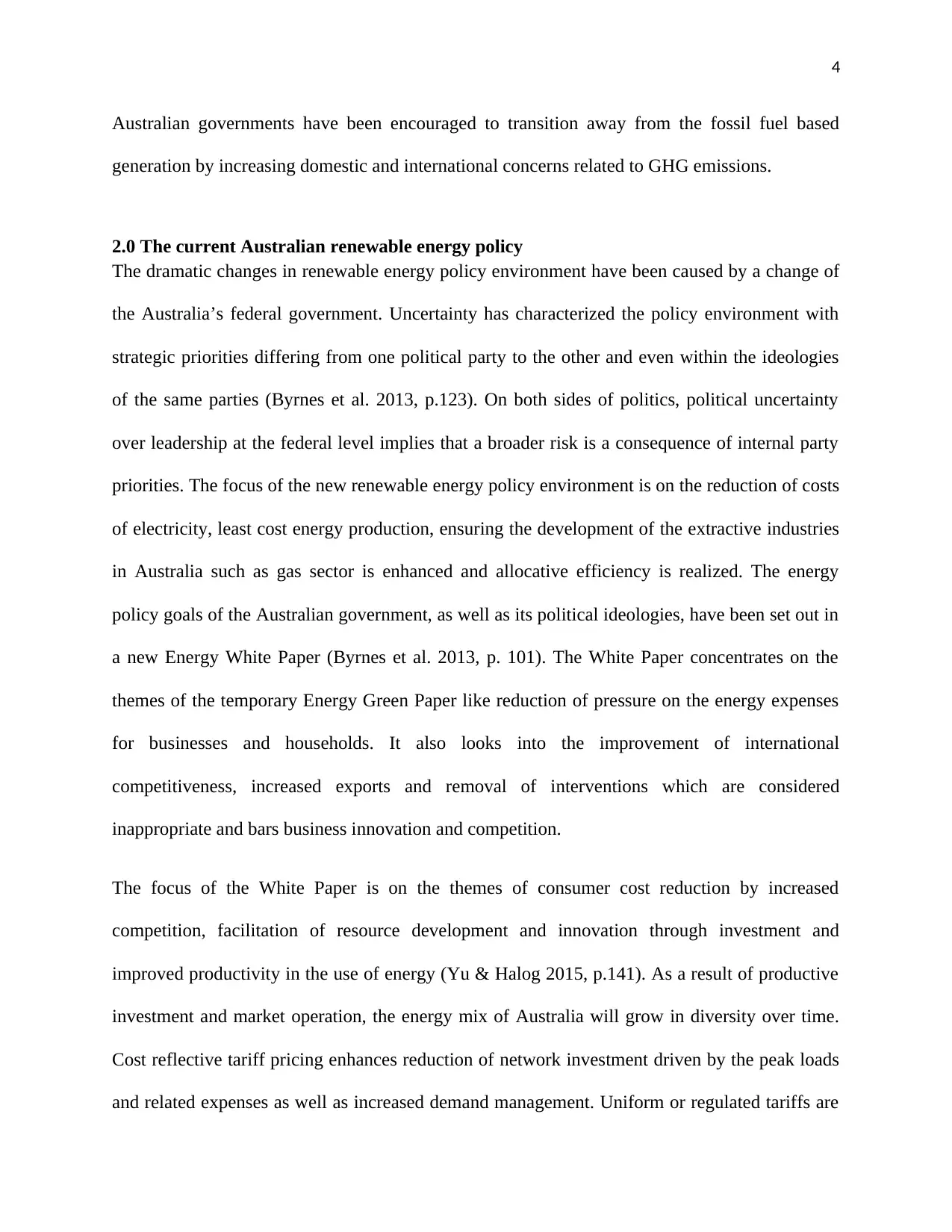
4
Australian governments have been encouraged to transition away from the fossil fuel based
generation by increasing domestic and international concerns related to GHG emissions.
2.0 The current Australian renewable energy policy
The dramatic changes in renewable energy policy environment have been caused by a change of
the Australia’s federal government. Uncertainty has characterized the policy environment with
strategic priorities differing from one political party to the other and even within the ideologies
of the same parties (Byrnes et al. 2013, p.123). On both sides of politics, political uncertainty
over leadership at the federal level implies that a broader risk is a consequence of internal party
priorities. The focus of the new renewable energy policy environment is on the reduction of costs
of electricity, least cost energy production, ensuring the development of the extractive industries
in Australia such as gas sector is enhanced and allocative efficiency is realized. The energy
policy goals of the Australian government, as well as its political ideologies, have been set out in
a new Energy White Paper (Byrnes et al. 2013, p. 101). The White Paper concentrates on the
themes of the temporary Energy Green Paper like reduction of pressure on the energy expenses
for businesses and households. It also looks into the improvement of international
competitiveness, increased exports and removal of interventions which are considered
inappropriate and bars business innovation and competition.
The focus of the White Paper is on the themes of consumer cost reduction by increased
competition, facilitation of resource development and innovation through investment and
improved productivity in the use of energy (Yu & Halog 2015, p.141). As a result of productive
investment and market operation, the energy mix of Australia will grow in diversity over time.
Cost reflective tariff pricing enhances reduction of network investment driven by the peak loads
and related expenses as well as increased demand management. Uniform or regulated tariffs are
Australian governments have been encouraged to transition away from the fossil fuel based
generation by increasing domestic and international concerns related to GHG emissions.
2.0 The current Australian renewable energy policy
The dramatic changes in renewable energy policy environment have been caused by a change of
the Australia’s federal government. Uncertainty has characterized the policy environment with
strategic priorities differing from one political party to the other and even within the ideologies
of the same parties (Byrnes et al. 2013, p.123). On both sides of politics, political uncertainty
over leadership at the federal level implies that a broader risk is a consequence of internal party
priorities. The focus of the new renewable energy policy environment is on the reduction of costs
of electricity, least cost energy production, ensuring the development of the extractive industries
in Australia such as gas sector is enhanced and allocative efficiency is realized. The energy
policy goals of the Australian government, as well as its political ideologies, have been set out in
a new Energy White Paper (Byrnes et al. 2013, p. 101). The White Paper concentrates on the
themes of the temporary Energy Green Paper like reduction of pressure on the energy expenses
for businesses and households. It also looks into the improvement of international
competitiveness, increased exports and removal of interventions which are considered
inappropriate and bars business innovation and competition.
The focus of the White Paper is on the themes of consumer cost reduction by increased
competition, facilitation of resource development and innovation through investment and
improved productivity in the use of energy (Yu & Halog 2015, p.141). As a result of productive
investment and market operation, the energy mix of Australia will grow in diversity over time.
Cost reflective tariff pricing enhances reduction of network investment driven by the peak loads
and related expenses as well as increased demand management. Uniform or regulated tariffs are
Secure Best Marks with AI Grader
Need help grading? Try our AI Grader for instant feedback on your assignments.

5
predominantly used in Australia (Byrnes et al. 2013, p.146). Despite the associated benefits in
the approach relating to reduced pressure on network investment and reduced cross-subsidies, it
is apparent that there is limited recognition of the capacity for issues touching on equity. It is also
arguable that the function of the non-monetary signals for the behavior of electricity demand for
some of the users. The users of rural electricity benefiting from subsidized electricity resulting
from the high cost of local supply are likely to face vulnerability to the policies of cost-reflective
tariffs.
Direct policy discussion related to renewable energy has been relatively minimal over an
extended period. The focus of the policy is in large part on ensuring that a (reduced) target of
renewables is kept and the Clean Energy Finance Corporation (CEFC) and Australian Renewable
Energy Agency (ARENA) are abolished. The roles of these government agencies include
facilitation of access to finance and commercialization of the technologies of renewable energy
(Head et al. 2014, p.66). Despite emissions abatement being a priority, internalizing externalities
of the environment which include emissions generated from the fossil fuels is not prioritized.
Nevertheless, the low emission technologies have a policy support especially coal which
undergoes carbon capture and storage. The policy environment set up by the government intends
to be neutral technologically because given the insights into the needs of the market; the industry
best makes decisions regarding investment on the assets which are to be generated in the future
including the technological choice.
The view that price signals are diluted, competition shielded and energy markets distorted is
reflected by the focus on the provision of subsidies and removal of regulatory barriers (Sims,
Rogner & Gregory 2003, p.134). The market regulations and interventions should not stifle
competition and consumer choice but should instead highly encourage such aspects, and cost-
predominantly used in Australia (Byrnes et al. 2013, p.146). Despite the associated benefits in
the approach relating to reduced pressure on network investment and reduced cross-subsidies, it
is apparent that there is limited recognition of the capacity for issues touching on equity. It is also
arguable that the function of the non-monetary signals for the behavior of electricity demand for
some of the users. The users of rural electricity benefiting from subsidized electricity resulting
from the high cost of local supply are likely to face vulnerability to the policies of cost-reflective
tariffs.
Direct policy discussion related to renewable energy has been relatively minimal over an
extended period. The focus of the policy is in large part on ensuring that a (reduced) target of
renewables is kept and the Clean Energy Finance Corporation (CEFC) and Australian Renewable
Energy Agency (ARENA) are abolished. The roles of these government agencies include
facilitation of access to finance and commercialization of the technologies of renewable energy
(Head et al. 2014, p.66). Despite emissions abatement being a priority, internalizing externalities
of the environment which include emissions generated from the fossil fuels is not prioritized.
Nevertheless, the low emission technologies have a policy support especially coal which
undergoes carbon capture and storage. The policy environment set up by the government intends
to be neutral technologically because given the insights into the needs of the market; the industry
best makes decisions regarding investment on the assets which are to be generated in the future
including the technological choice.
The view that price signals are diluted, competition shielded and energy markets distorted is
reflected by the focus on the provision of subsidies and removal of regulatory barriers (Sims,
Rogner & Gregory 2003, p.134). The market regulations and interventions should not stifle
competition and consumer choice but should instead highly encourage such aspects, and cost-

6
benefit analysis is a primary requirement needed for such regulations. Definition of investment
outcomes is driven by the inherent focus on the use of the competitive energy markets. The
greater focus on the policy appears to be in the gas industry development, export of energy such
as uranium, gas and coal and driving competitiveness. The table below shows the various
changes to key policies which exist, impacting the occurrence of renewables since 2013 and the
focus are on the examination of the policies' roles and implications (Council 2014, p.75).
Table 1: Key policies on renewable energy and their status
Policy instrument Does it
exist?
The comments
Emissions Reduction Fund (ERF) Yes The recent policy initiative of ERF is
designed to encourage the abatement of least
cost investment. Nevertheless, it is not likely
to have direct support for the renewable
sector.
Carbon pricing scheme (Operative
2011-2014)
No In 2014, the plan was repealed, and in the
short term, the price of carbon is unlikely.
ARENA Yes ARENA's future is uncertain. There is the
commitment by the Federal government for its
closure although the Senate has prevented this
step. The government will honor the existing
benefit analysis is a primary requirement needed for such regulations. Definition of investment
outcomes is driven by the inherent focus on the use of the competitive energy markets. The
greater focus on the policy appears to be in the gas industry development, export of energy such
as uranium, gas and coal and driving competitiveness. The table below shows the various
changes to key policies which exist, impacting the occurrence of renewables since 2013 and the
focus are on the examination of the policies' roles and implications (Council 2014, p.75).
Table 1: Key policies on renewable energy and their status
Policy instrument Does it
exist?
The comments
Emissions Reduction Fund (ERF) Yes The recent policy initiative of ERF is
designed to encourage the abatement of least
cost investment. Nevertheless, it is not likely
to have direct support for the renewable
sector.
Carbon pricing scheme (Operative
2011-2014)
No In 2014, the plan was repealed, and in the
short term, the price of carbon is unlikely.
ARENA Yes ARENA's future is uncertain. There is the
commitment by the Federal government for its
closure although the Senate has prevented this
step. The government will honor the existing
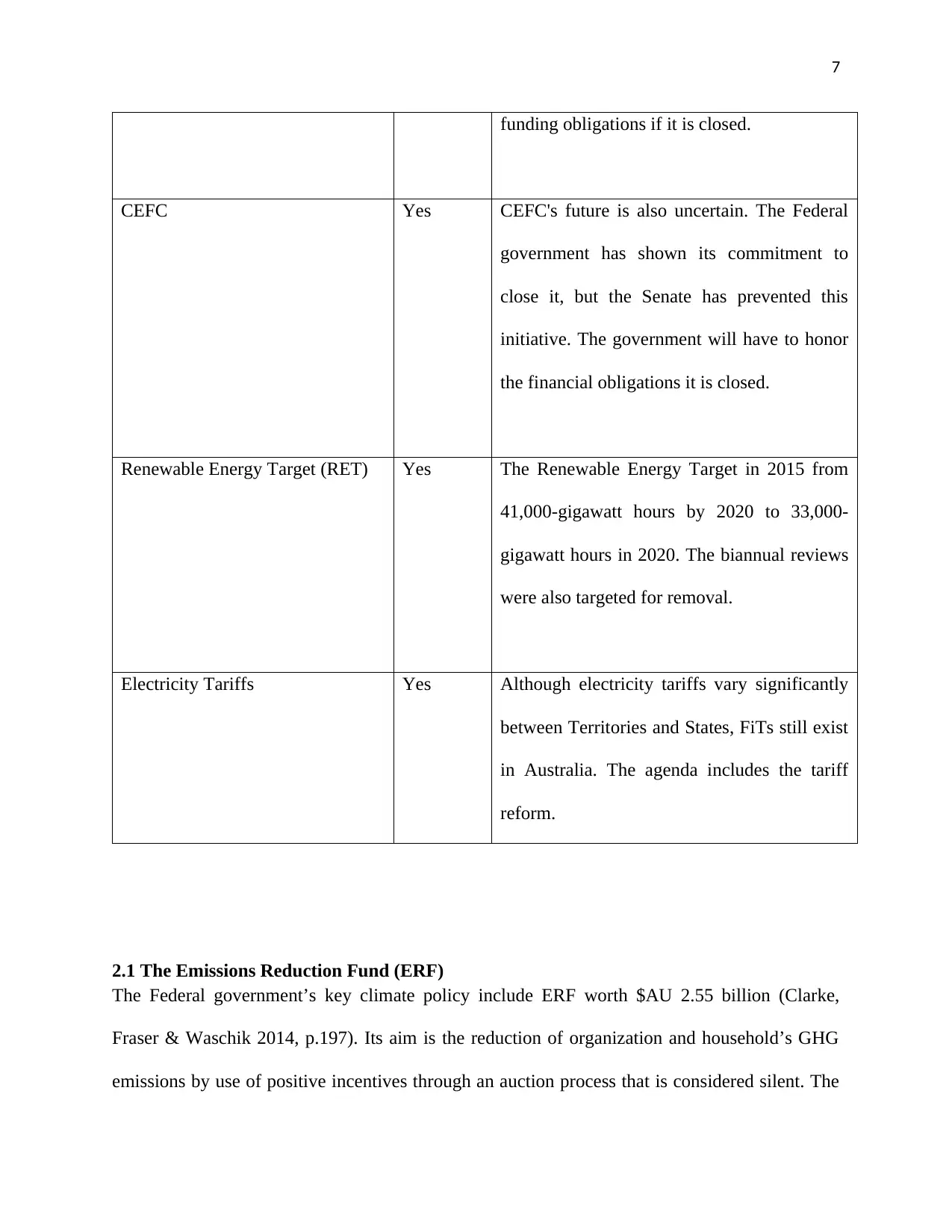
7
funding obligations if it is closed.
CEFC Yes CEFC's future is also uncertain. The Federal
government has shown its commitment to
close it, but the Senate has prevented this
initiative. The government will have to honor
the financial obligations it is closed.
Renewable Energy Target (RET) Yes The Renewable Energy Target in 2015 from
41,000-gigawatt hours by 2020 to 33,000-
gigawatt hours in 2020. The biannual reviews
were also targeted for removal.
Electricity Tariffs Yes Although electricity tariffs vary significantly
between Territories and States, FiTs still exist
in Australia. The agenda includes the tariff
reform.
2.1 The Emissions Reduction Fund (ERF)
The Federal government’s key climate policy include ERF worth $AU 2.55 billion (Clarke,
Fraser & Waschik 2014, p.197). Its aim is the reduction of organization and household’s GHG
emissions by use of positive incentives through an auction process that is considered silent. The
funding obligations if it is closed.
CEFC Yes CEFC's future is also uncertain. The Federal
government has shown its commitment to
close it, but the Senate has prevented this
initiative. The government will have to honor
the financial obligations it is closed.
Renewable Energy Target (RET) Yes The Renewable Energy Target in 2015 from
41,000-gigawatt hours by 2020 to 33,000-
gigawatt hours in 2020. The biannual reviews
were also targeted for removal.
Electricity Tariffs Yes Although electricity tariffs vary significantly
between Territories and States, FiTs still exist
in Australia. The agenda includes the tariff
reform.
2.1 The Emissions Reduction Fund (ERF)
The Federal government’s key climate policy include ERF worth $AU 2.55 billion (Clarke,
Fraser & Waschik 2014, p.197). Its aim is the reduction of organization and household’s GHG
emissions by use of positive incentives through an auction process that is considered silent. The
Paraphrase This Document
Need a fresh take? Get an instant paraphrase of this document with our AI Paraphraser
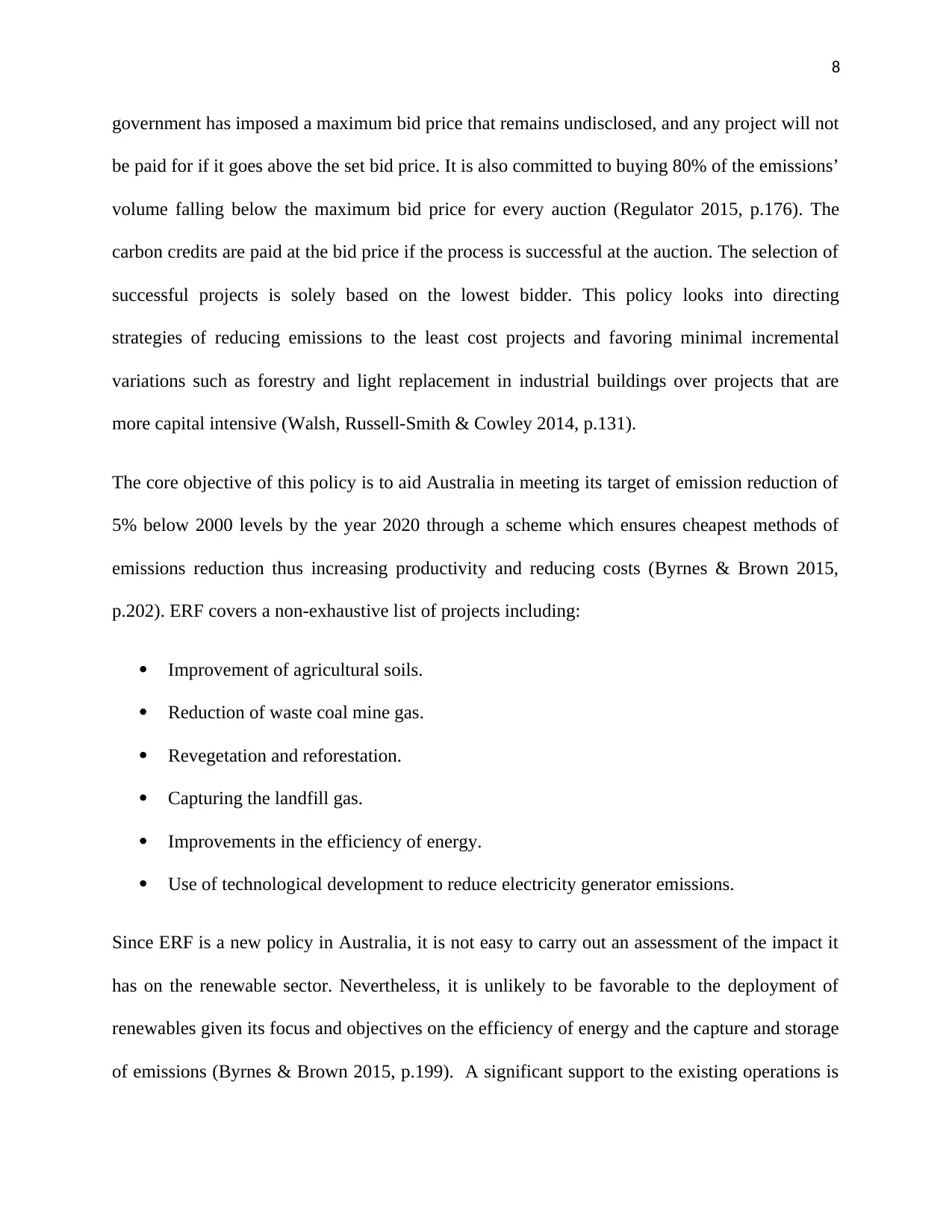
8
government has imposed a maximum bid price that remains undisclosed, and any project will not
be paid for if it goes above the set bid price. It is also committed to buying 80% of the emissions’
volume falling below the maximum bid price for every auction (Regulator 2015, p.176). The
carbon credits are paid at the bid price if the process is successful at the auction. The selection of
successful projects is solely based on the lowest bidder. This policy looks into directing
strategies of reducing emissions to the least cost projects and favoring minimal incremental
variations such as forestry and light replacement in industrial buildings over projects that are
more capital intensive (Walsh, Russell-Smith & Cowley 2014, p.131).
The core objective of this policy is to aid Australia in meeting its target of emission reduction of
5% below 2000 levels by the year 2020 through a scheme which ensures cheapest methods of
emissions reduction thus increasing productivity and reducing costs (Byrnes & Brown 2015,
p.202). ERF covers a non-exhaustive list of projects including:
Improvement of agricultural soils.
Reduction of waste coal mine gas.
Revegetation and reforestation.
Capturing the landfill gas.
Improvements in the efficiency of energy.
Use of technological development to reduce electricity generator emissions.
Since ERF is a new policy in Australia, it is not easy to carry out an assessment of the impact it
has on the renewable sector. Nevertheless, it is unlikely to be favorable to the deployment of
renewables given its focus and objectives on the efficiency of energy and the capture and storage
of emissions (Byrnes & Brown 2015, p.199). A significant support to the existing operations is
government has imposed a maximum bid price that remains undisclosed, and any project will not
be paid for if it goes above the set bid price. It is also committed to buying 80% of the emissions’
volume falling below the maximum bid price for every auction (Regulator 2015, p.176). The
carbon credits are paid at the bid price if the process is successful at the auction. The selection of
successful projects is solely based on the lowest bidder. This policy looks into directing
strategies of reducing emissions to the least cost projects and favoring minimal incremental
variations such as forestry and light replacement in industrial buildings over projects that are
more capital intensive (Walsh, Russell-Smith & Cowley 2014, p.131).
The core objective of this policy is to aid Australia in meeting its target of emission reduction of
5% below 2000 levels by the year 2020 through a scheme which ensures cheapest methods of
emissions reduction thus increasing productivity and reducing costs (Byrnes & Brown 2015,
p.202). ERF covers a non-exhaustive list of projects including:
Improvement of agricultural soils.
Reduction of waste coal mine gas.
Revegetation and reforestation.
Capturing the landfill gas.
Improvements in the efficiency of energy.
Use of technological development to reduce electricity generator emissions.
Since ERF is a new policy in Australia, it is not easy to carry out an assessment of the impact it
has on the renewable sector. Nevertheless, it is unlikely to be favorable to the deployment of
renewables given its focus and objectives on the efficiency of energy and the capture and storage
of emissions (Byrnes & Brown 2015, p.199). A significant support to the existing operations is
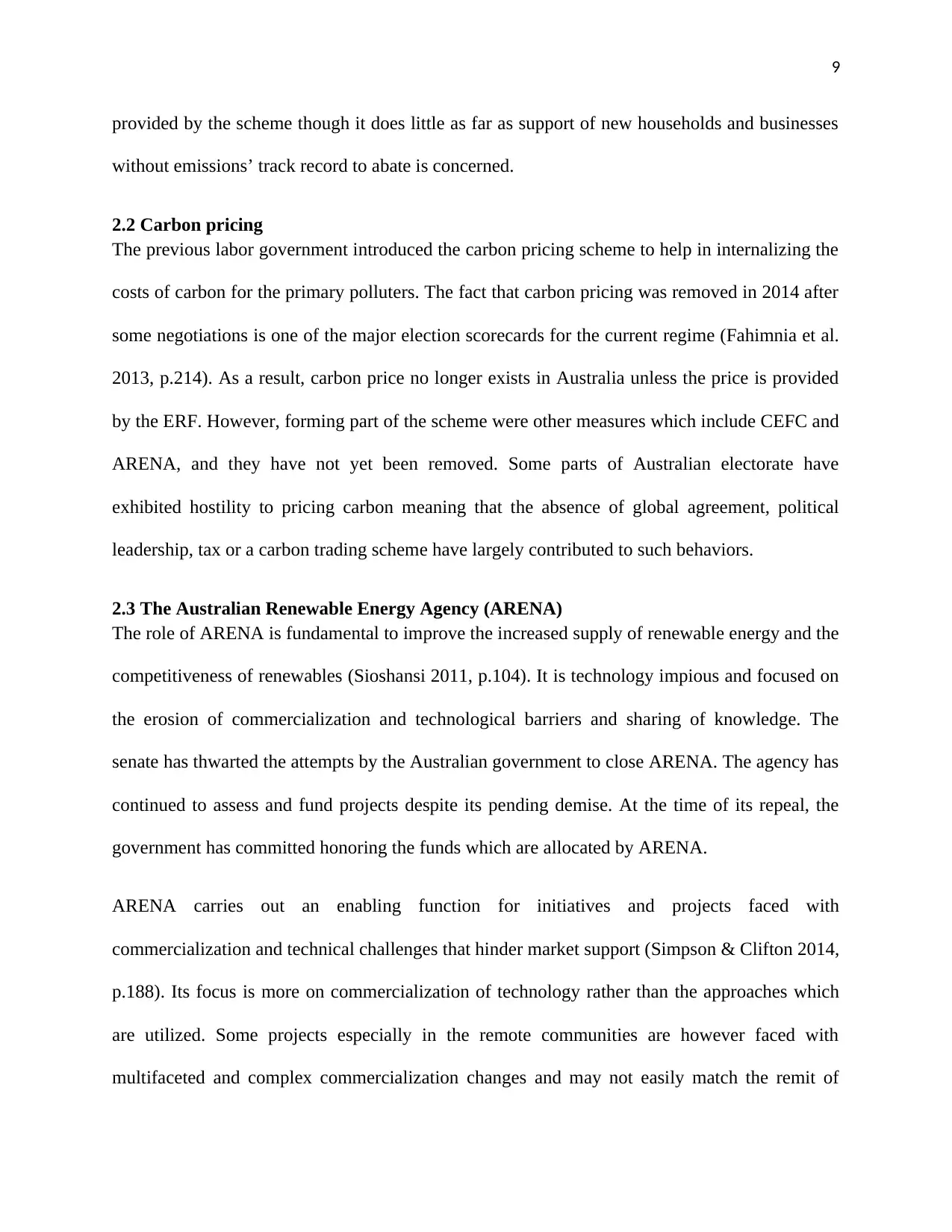
9
provided by the scheme though it does little as far as support of new households and businesses
without emissions’ track record to abate is concerned.
2.2 Carbon pricing
The previous labor government introduced the carbon pricing scheme to help in internalizing the
costs of carbon for the primary polluters. The fact that carbon pricing was removed in 2014 after
some negotiations is one of the major election scorecards for the current regime (Fahimnia et al.
2013, p.214). As a result, carbon price no longer exists in Australia unless the price is provided
by the ERF. However, forming part of the scheme were other measures which include CEFC and
ARENA, and they have not yet been removed. Some parts of Australian electorate have
exhibited hostility to pricing carbon meaning that the absence of global agreement, political
leadership, tax or a carbon trading scheme have largely contributed to such behaviors.
2.3 The Australian Renewable Energy Agency (ARENA)
The role of ARENA is fundamental to improve the increased supply of renewable energy and the
competitiveness of renewables (Sioshansi 2011, p.104). It is technology impious and focused on
the erosion of commercialization and technological barriers and sharing of knowledge. The
senate has thwarted the attempts by the Australian government to close ARENA. The agency has
continued to assess and fund projects despite its pending demise. At the time of its repeal, the
government has committed honoring the funds which are allocated by ARENA.
ARENA carries out an enabling function for initiatives and projects faced with
commercialization and technical challenges that hinder market support (Simpson & Clifton 2014,
p.188). Its focus is more on commercialization of technology rather than the approaches which
are utilized. Some projects especially in the remote communities are however faced with
multifaceted and complex commercialization changes and may not easily match the remit of
provided by the scheme though it does little as far as support of new households and businesses
without emissions’ track record to abate is concerned.
2.2 Carbon pricing
The previous labor government introduced the carbon pricing scheme to help in internalizing the
costs of carbon for the primary polluters. The fact that carbon pricing was removed in 2014 after
some negotiations is one of the major election scorecards for the current regime (Fahimnia et al.
2013, p.214). As a result, carbon price no longer exists in Australia unless the price is provided
by the ERF. However, forming part of the scheme were other measures which include CEFC and
ARENA, and they have not yet been removed. Some parts of Australian electorate have
exhibited hostility to pricing carbon meaning that the absence of global agreement, political
leadership, tax or a carbon trading scheme have largely contributed to such behaviors.
2.3 The Australian Renewable Energy Agency (ARENA)
The role of ARENA is fundamental to improve the increased supply of renewable energy and the
competitiveness of renewables (Sioshansi 2011, p.104). It is technology impious and focused on
the erosion of commercialization and technological barriers and sharing of knowledge. The
senate has thwarted the attempts by the Australian government to close ARENA. The agency has
continued to assess and fund projects despite its pending demise. At the time of its repeal, the
government has committed honoring the funds which are allocated by ARENA.
ARENA carries out an enabling function for initiatives and projects faced with
commercialization and technical challenges that hinder market support (Simpson & Clifton 2014,
p.188). Its focus is more on commercialization of technology rather than the approaches which
are utilized. Some projects especially in the remote communities are however faced with
multifaceted and complex commercialization changes and may not easily match the remit of

10
ARENA. The kind of risk that surrounds the future of ARENA is not conducive to the
deployment of renewables. The project development is resource and time intensive. The
incentive for resource and time allocation is most likely to lead to the reduction of particular
uncertainty concerning the future of ARENA.
2.4 The Clean Energy Finance Corporation (CEFC)
The CEFC is a financier getting its funds from the government to aid in overcoming the funding
challenges which are associated with the development of clean energy including technologies on
low emissions and renewable energy. Its focus is on the provision of funds at a concessional rate
for projects on clean energy with a positive rate of return. The concession highly relies on the
benefits that do not emanate from within provided by the project and can be in the form of longer
duration, reduced costs and higher rate of risk (Hua, Oliphant & Hu 2016, p.45).
The Senate has barred the commitment by the Australian government to ensure CEFC is closed.
The reason for the closure of CEFC comes into sight to provide a reflection on the perception
that the government is not to provide funds if the profile of the project risk is unacceptable to the
private sector. The CEO of CEFC asserted that the willingness of private financier to take part in
the Australian market had been reduced by the uncertain and complex policy environment
(Martin & Rice 2015, p.97). Therefore, the CEFC’s role is critical due to this policy
environment. The availability of finance is restricted by the tendency to focus on established
businesses and the requirement for concessional market returns in an attempt to take charge of
the profile of credit risk. The large projects with lower transaction costs have high capacity to
attract finance from the CEFC specifically those that involve more established businesses. The
organizations which are less established with limited access to funding like smaller projects,
small businesses or community groups may not be included (Hua, Oliphant & Hu 2016, p.49).
ARENA. The kind of risk that surrounds the future of ARENA is not conducive to the
deployment of renewables. The project development is resource and time intensive. The
incentive for resource and time allocation is most likely to lead to the reduction of particular
uncertainty concerning the future of ARENA.
2.4 The Clean Energy Finance Corporation (CEFC)
The CEFC is a financier getting its funds from the government to aid in overcoming the funding
challenges which are associated with the development of clean energy including technologies on
low emissions and renewable energy. Its focus is on the provision of funds at a concessional rate
for projects on clean energy with a positive rate of return. The concession highly relies on the
benefits that do not emanate from within provided by the project and can be in the form of longer
duration, reduced costs and higher rate of risk (Hua, Oliphant & Hu 2016, p.45).
The Senate has barred the commitment by the Australian government to ensure CEFC is closed.
The reason for the closure of CEFC comes into sight to provide a reflection on the perception
that the government is not to provide funds if the profile of the project risk is unacceptable to the
private sector. The CEO of CEFC asserted that the willingness of private financier to take part in
the Australian market had been reduced by the uncertain and complex policy environment
(Martin & Rice 2015, p.97). Therefore, the CEFC’s role is critical due to this policy
environment. The availability of finance is restricted by the tendency to focus on established
businesses and the requirement for concessional market returns in an attempt to take charge of
the profile of credit risk. The large projects with lower transaction costs have high capacity to
attract finance from the CEFC specifically those that involve more established businesses. The
organizations which are less established with limited access to funding like smaller projects,
small businesses or community groups may not be included (Hua, Oliphant & Hu 2016, p.49).
Secure Best Marks with AI Grader
Need help grading? Try our AI Grader for instant feedback on your assignments.

11
Lack of products’ standardization, high costs of transactions, perceived risks of investment,
locational challenges, inability to acquire co-finance or complexity related to the alignment of
stakeholders are some of the causes for their exclusion.
2.5 The Renewable Energy Target (RET)
The aim of RET is the reduction of GHG emissions from the generation of electricity through the
provision of certificates for generation of renewable energy (Cludius, Forrest & MacGill 2014,
p.55). The large systems are given proper documentation based on the generated MWh while the
small systems which are less than 100 kW are provided with upfront payments. The electricity
retailers who are liable entities have to make purchases of a given number of certificates. This
policy is significant as it has played a key function in the facilitation of the deployment of
renewables and reduction of emissions in Australia. RET was reviewed in 2014 by the federal
government (Panel 2014, p.133) signaling its intention to have the target reduced and it was
concluded that:
Given the availability of abatement alternatives for lower cost emission, the cost to the
community of the RET has shot up.
RET is funded via a cross-subsidy by the consumers, electricity retailers and incumbent
generators.
The impact of RET on the prices of electricity is small.
Approximately $13 billion of the large-scale generation which is not required will be
developed given the changes in the electricity environment.
RET provides investment incentive in the production of renewable energy which is not
essential in meeting demand and not viable without subsidy by RET.
Lack of products’ standardization, high costs of transactions, perceived risks of investment,
locational challenges, inability to acquire co-finance or complexity related to the alignment of
stakeholders are some of the causes for their exclusion.
2.5 The Renewable Energy Target (RET)
The aim of RET is the reduction of GHG emissions from the generation of electricity through the
provision of certificates for generation of renewable energy (Cludius, Forrest & MacGill 2014,
p.55). The large systems are given proper documentation based on the generated MWh while the
small systems which are less than 100 kW are provided with upfront payments. The electricity
retailers who are liable entities have to make purchases of a given number of certificates. This
policy is significant as it has played a key function in the facilitation of the deployment of
renewables and reduction of emissions in Australia. RET was reviewed in 2014 by the federal
government (Panel 2014, p.133) signaling its intention to have the target reduced and it was
concluded that:
Given the availability of abatement alternatives for lower cost emission, the cost to the
community of the RET has shot up.
RET is funded via a cross-subsidy by the consumers, electricity retailers and incumbent
generators.
The impact of RET on the prices of electricity is small.
Approximately $13 billion of the large-scale generation which is not required will be
developed given the changes in the electricity environment.
RET provides investment incentive in the production of renewable energy which is not
essential in meeting demand and not viable without subsidy by RET.
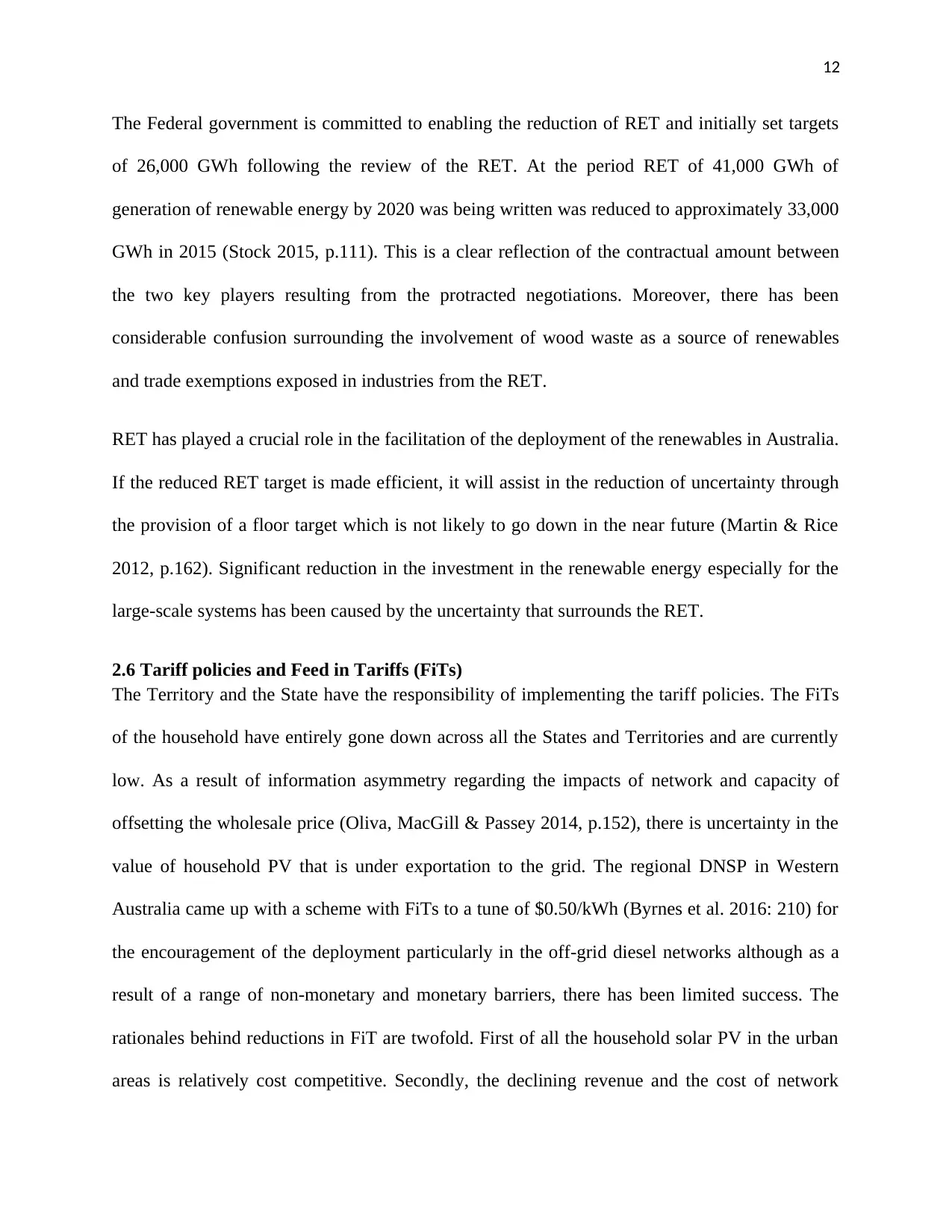
12
The Federal government is committed to enabling the reduction of RET and initially set targets
of 26,000 GWh following the review of the RET. At the period RET of 41,000 GWh of
generation of renewable energy by 2020 was being written was reduced to approximately 33,000
GWh in 2015 (Stock 2015, p.111). This is a clear reflection of the contractual amount between
the two key players resulting from the protracted negotiations. Moreover, there has been
considerable confusion surrounding the involvement of wood waste as a source of renewables
and trade exemptions exposed in industries from the RET.
RET has played a crucial role in the facilitation of the deployment of the renewables in Australia.
If the reduced RET target is made efficient, it will assist in the reduction of uncertainty through
the provision of a floor target which is not likely to go down in the near future (Martin & Rice
2012, p.162). Significant reduction in the investment in the renewable energy especially for the
large-scale systems has been caused by the uncertainty that surrounds the RET.
2.6 Tariff policies and Feed in Tariffs (FiTs)
The Territory and the State have the responsibility of implementing the tariff policies. The FiTs
of the household have entirely gone down across all the States and Territories and are currently
low. As a result of information asymmetry regarding the impacts of network and capacity of
offsetting the wholesale price (Oliva, MacGill & Passey 2014, p.152), there is uncertainty in the
value of household PV that is under exportation to the grid. The regional DNSP in Western
Australia came up with a scheme with FiTs to a tune of $0.50/kWh (Byrnes et al. 2016: 210) for
the encouragement of the deployment particularly in the off-grid diesel networks although as a
result of a range of non-monetary and monetary barriers, there has been limited success. The
rationales behind reductions in FiT are twofold. First of all the household solar PV in the urban
areas is relatively cost competitive. Secondly, the declining revenue and the cost of network
The Federal government is committed to enabling the reduction of RET and initially set targets
of 26,000 GWh following the review of the RET. At the period RET of 41,000 GWh of
generation of renewable energy by 2020 was being written was reduced to approximately 33,000
GWh in 2015 (Stock 2015, p.111). This is a clear reflection of the contractual amount between
the two key players resulting from the protracted negotiations. Moreover, there has been
considerable confusion surrounding the involvement of wood waste as a source of renewables
and trade exemptions exposed in industries from the RET.
RET has played a crucial role in the facilitation of the deployment of the renewables in Australia.
If the reduced RET target is made efficient, it will assist in the reduction of uncertainty through
the provision of a floor target which is not likely to go down in the near future (Martin & Rice
2012, p.162). Significant reduction in the investment in the renewable energy especially for the
large-scale systems has been caused by the uncertainty that surrounds the RET.
2.6 Tariff policies and Feed in Tariffs (FiTs)
The Territory and the State have the responsibility of implementing the tariff policies. The FiTs
of the household have entirely gone down across all the States and Territories and are currently
low. As a result of information asymmetry regarding the impacts of network and capacity of
offsetting the wholesale price (Oliva, MacGill & Passey 2014, p.152), there is uncertainty in the
value of household PV that is under exportation to the grid. The regional DNSP in Western
Australia came up with a scheme with FiTs to a tune of $0.50/kWh (Byrnes et al. 2016: 210) for
the encouragement of the deployment particularly in the off-grid diesel networks although as a
result of a range of non-monetary and monetary barriers, there has been limited success. The
rationales behind reductions in FiT are twofold. First of all the household solar PV in the urban
areas is relatively cost competitive. Secondly, the declining revenue and the cost of network
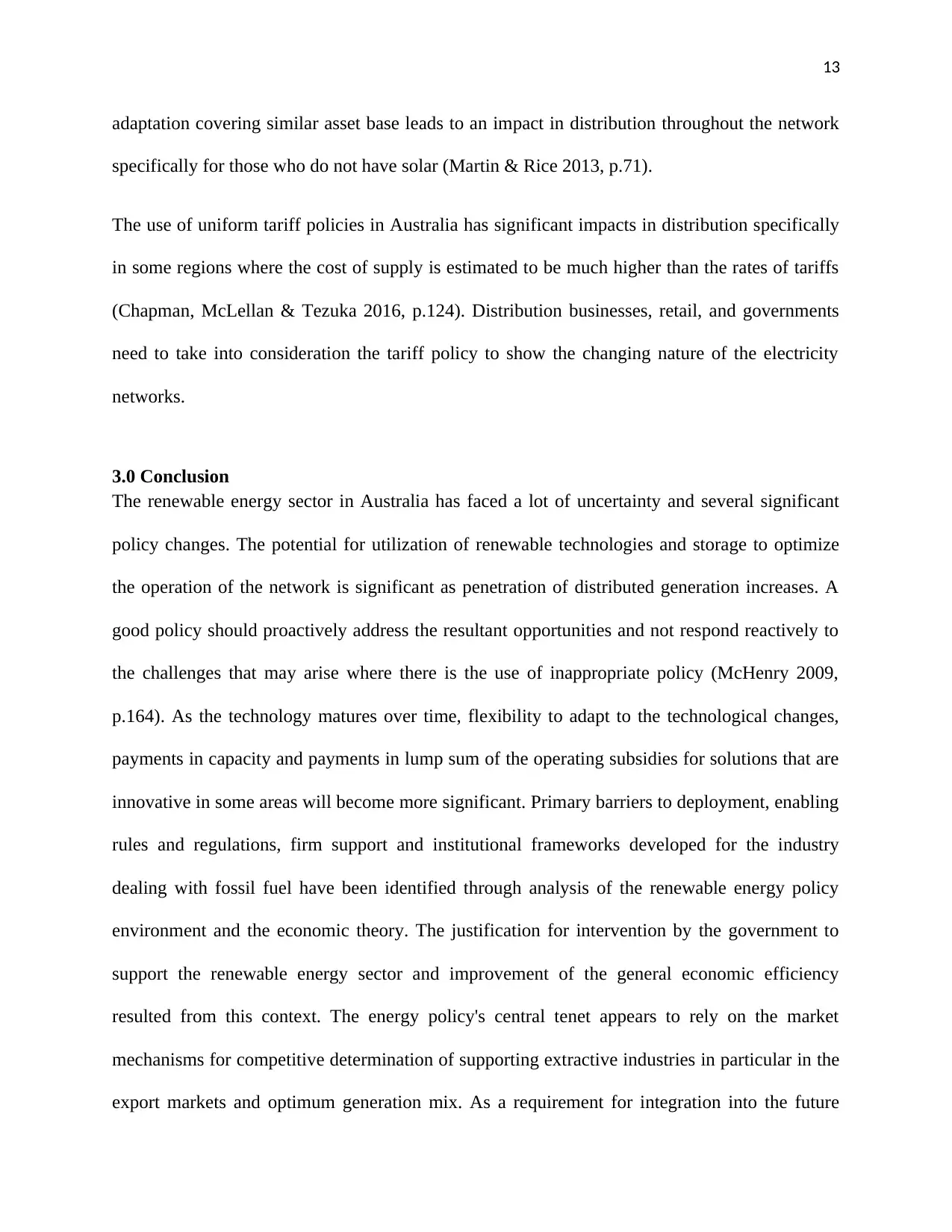
13
adaptation covering similar asset base leads to an impact in distribution throughout the network
specifically for those who do not have solar (Martin & Rice 2013, p.71).
The use of uniform tariff policies in Australia has significant impacts in distribution specifically
in some regions where the cost of supply is estimated to be much higher than the rates of tariffs
(Chapman, McLellan & Tezuka 2016, p.124). Distribution businesses, retail, and governments
need to take into consideration the tariff policy to show the changing nature of the electricity
networks.
3.0 Conclusion
The renewable energy sector in Australia has faced a lot of uncertainty and several significant
policy changes. The potential for utilization of renewable technologies and storage to optimize
the operation of the network is significant as penetration of distributed generation increases. A
good policy should proactively address the resultant opportunities and not respond reactively to
the challenges that may arise where there is the use of inappropriate policy (McHenry 2009,
p.164). As the technology matures over time, flexibility to adapt to the technological changes,
payments in capacity and payments in lump sum of the operating subsidies for solutions that are
innovative in some areas will become more significant. Primary barriers to deployment, enabling
rules and regulations, firm support and institutional frameworks developed for the industry
dealing with fossil fuel have been identified through analysis of the renewable energy policy
environment and the economic theory. The justification for intervention by the government to
support the renewable energy sector and improvement of the general economic efficiency
resulted from this context. The energy policy's central tenet appears to rely on the market
mechanisms for competitive determination of supporting extractive industries in particular in the
export markets and optimum generation mix. As a requirement for integration into the future
adaptation covering similar asset base leads to an impact in distribution throughout the network
specifically for those who do not have solar (Martin & Rice 2013, p.71).
The use of uniform tariff policies in Australia has significant impacts in distribution specifically
in some regions where the cost of supply is estimated to be much higher than the rates of tariffs
(Chapman, McLellan & Tezuka 2016, p.124). Distribution businesses, retail, and governments
need to take into consideration the tariff policy to show the changing nature of the electricity
networks.
3.0 Conclusion
The renewable energy sector in Australia has faced a lot of uncertainty and several significant
policy changes. The potential for utilization of renewable technologies and storage to optimize
the operation of the network is significant as penetration of distributed generation increases. A
good policy should proactively address the resultant opportunities and not respond reactively to
the challenges that may arise where there is the use of inappropriate policy (McHenry 2009,
p.164). As the technology matures over time, flexibility to adapt to the technological changes,
payments in capacity and payments in lump sum of the operating subsidies for solutions that are
innovative in some areas will become more significant. Primary barriers to deployment, enabling
rules and regulations, firm support and institutional frameworks developed for the industry
dealing with fossil fuel have been identified through analysis of the renewable energy policy
environment and the economic theory. The justification for intervention by the government to
support the renewable energy sector and improvement of the general economic efficiency
resulted from this context. The energy policy's central tenet appears to rely on the market
mechanisms for competitive determination of supporting extractive industries in particular in the
export markets and optimum generation mix. As a requirement for integration into the future
Paraphrase This Document
Need a fresh take? Get an instant paraphrase of this document with our AI Paraphraser

14
energy mix, it implies that the market will efficiently develop innovative solutions and direct
enough resources.
energy mix, it implies that the market will efficiently develop innovative solutions and direct
enough resources.
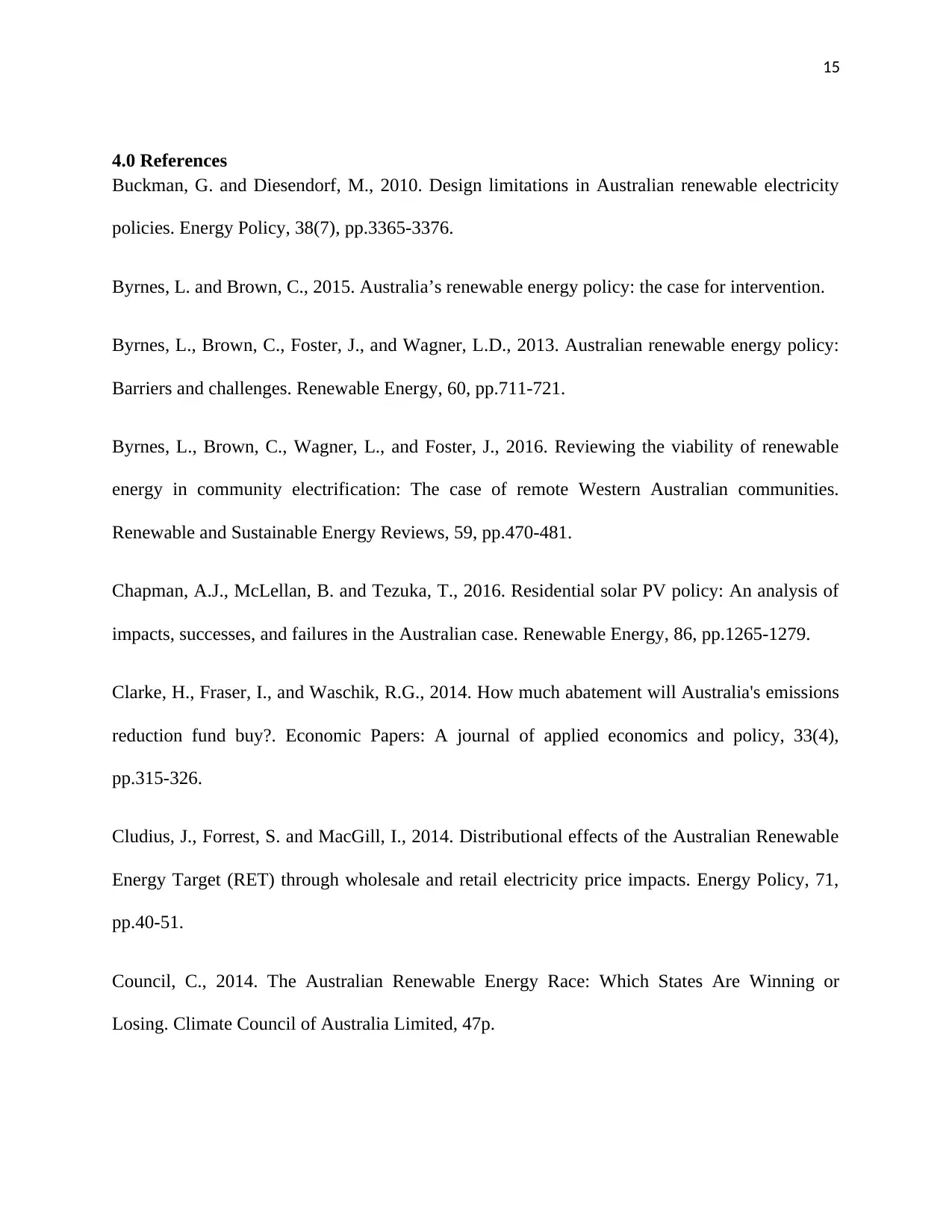
15
4.0 References
Buckman, G. and Diesendorf, M., 2010. Design limitations in Australian renewable electricity
policies. Energy Policy, 38(7), pp.3365-3376.
Byrnes, L. and Brown, C., 2015. Australia’s renewable energy policy: the case for intervention.
Byrnes, L., Brown, C., Foster, J., and Wagner, L.D., 2013. Australian renewable energy policy:
Barriers and challenges. Renewable Energy, 60, pp.711-721.
Byrnes, L., Brown, C., Wagner, L., and Foster, J., 2016. Reviewing the viability of renewable
energy in community electrification: The case of remote Western Australian communities.
Renewable and Sustainable Energy Reviews, 59, pp.470-481.
Chapman, A.J., McLellan, B. and Tezuka, T., 2016. Residential solar PV policy: An analysis of
impacts, successes, and failures in the Australian case. Renewable Energy, 86, pp.1265-1279.
Clarke, H., Fraser, I., and Waschik, R.G., 2014. How much abatement will Australia's emissions
reduction fund buy?. Economic Papers: A journal of applied economics and policy, 33(4),
pp.315-326.
Cludius, J., Forrest, S. and MacGill, I., 2014. Distributional effects of the Australian Renewable
Energy Target (RET) through wholesale and retail electricity price impacts. Energy Policy, 71,
pp.40-51.
Council, C., 2014. The Australian Renewable Energy Race: Which States Are Winning or
Losing. Climate Council of Australia Limited, 47p.
4.0 References
Buckman, G. and Diesendorf, M., 2010. Design limitations in Australian renewable electricity
policies. Energy Policy, 38(7), pp.3365-3376.
Byrnes, L. and Brown, C., 2015. Australia’s renewable energy policy: the case for intervention.
Byrnes, L., Brown, C., Foster, J., and Wagner, L.D., 2013. Australian renewable energy policy:
Barriers and challenges. Renewable Energy, 60, pp.711-721.
Byrnes, L., Brown, C., Wagner, L., and Foster, J., 2016. Reviewing the viability of renewable
energy in community electrification: The case of remote Western Australian communities.
Renewable and Sustainable Energy Reviews, 59, pp.470-481.
Chapman, A.J., McLellan, B. and Tezuka, T., 2016. Residential solar PV policy: An analysis of
impacts, successes, and failures in the Australian case. Renewable Energy, 86, pp.1265-1279.
Clarke, H., Fraser, I., and Waschik, R.G., 2014. How much abatement will Australia's emissions
reduction fund buy?. Economic Papers: A journal of applied economics and policy, 33(4),
pp.315-326.
Cludius, J., Forrest, S. and MacGill, I., 2014. Distributional effects of the Australian Renewable
Energy Target (RET) through wholesale and retail electricity price impacts. Energy Policy, 71,
pp.40-51.
Council, C., 2014. The Australian Renewable Energy Race: Which States Are Winning or
Losing. Climate Council of Australia Limited, 47p.
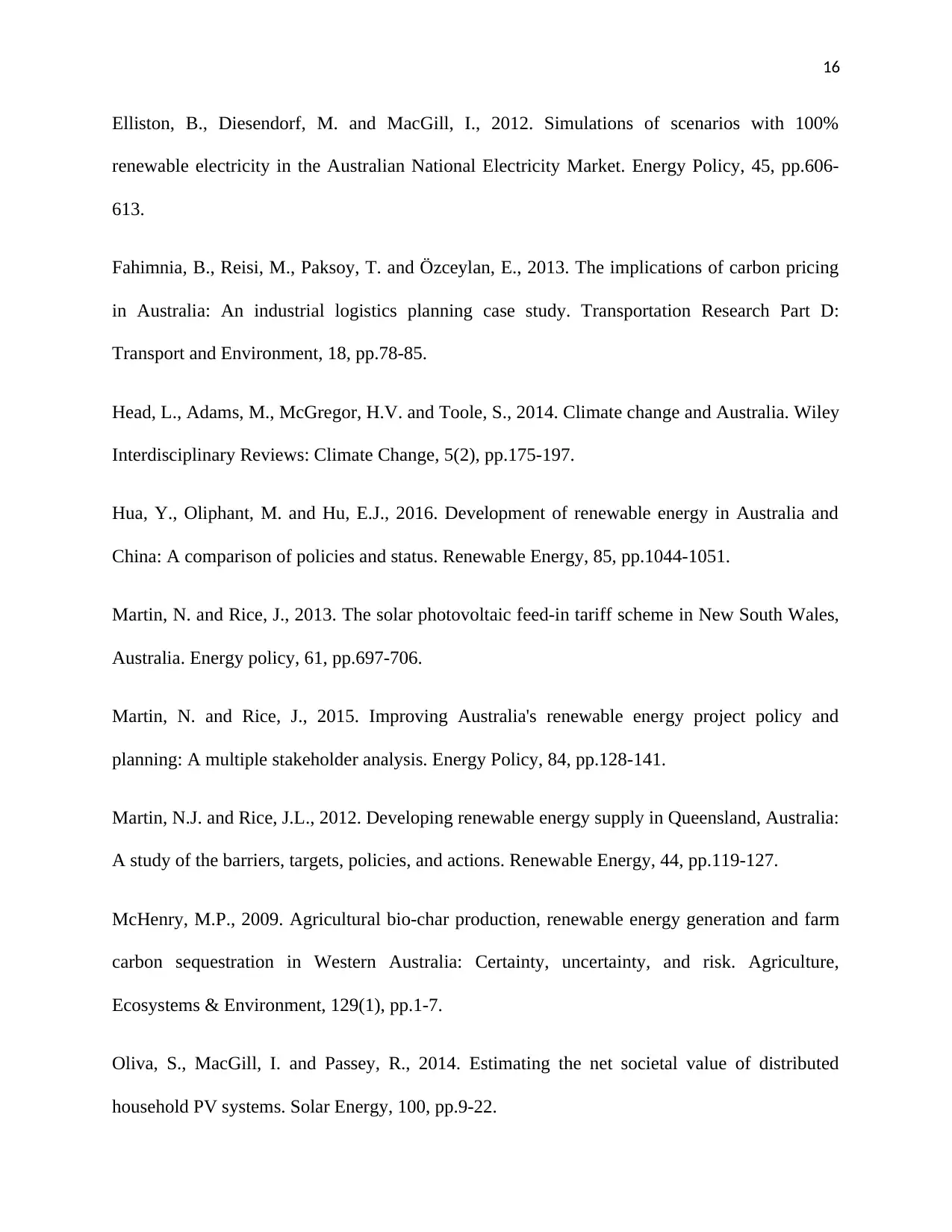
16
Elliston, B., Diesendorf, M. and MacGill, I., 2012. Simulations of scenarios with 100%
renewable electricity in the Australian National Electricity Market. Energy Policy, 45, pp.606-
613.
Fahimnia, B., Reisi, M., Paksoy, T. and Özceylan, E., 2013. The implications of carbon pricing
in Australia: An industrial logistics planning case study. Transportation Research Part D:
Transport and Environment, 18, pp.78-85.
Head, L., Adams, M., McGregor, H.V. and Toole, S., 2014. Climate change and Australia. Wiley
Interdisciplinary Reviews: Climate Change, 5(2), pp.175-197.
Hua, Y., Oliphant, M. and Hu, E.J., 2016. Development of renewable energy in Australia and
China: A comparison of policies and status. Renewable Energy, 85, pp.1044-1051.
Martin, N. and Rice, J., 2013. The solar photovoltaic feed-in tariff scheme in New South Wales,
Australia. Energy policy, 61, pp.697-706.
Martin, N. and Rice, J., 2015. Improving Australia's renewable energy project policy and
planning: A multiple stakeholder analysis. Energy Policy, 84, pp.128-141.
Martin, N.J. and Rice, J.L., 2012. Developing renewable energy supply in Queensland, Australia:
A study of the barriers, targets, policies, and actions. Renewable Energy, 44, pp.119-127.
McHenry, M.P., 2009. Agricultural bio-char production, renewable energy generation and farm
carbon sequestration in Western Australia: Certainty, uncertainty, and risk. Agriculture,
Ecosystems & Environment, 129(1), pp.1-7.
Oliva, S., MacGill, I. and Passey, R., 2014. Estimating the net societal value of distributed
household PV systems. Solar Energy, 100, pp.9-22.
Elliston, B., Diesendorf, M. and MacGill, I., 2012. Simulations of scenarios with 100%
renewable electricity in the Australian National Electricity Market. Energy Policy, 45, pp.606-
613.
Fahimnia, B., Reisi, M., Paksoy, T. and Özceylan, E., 2013. The implications of carbon pricing
in Australia: An industrial logistics planning case study. Transportation Research Part D:
Transport and Environment, 18, pp.78-85.
Head, L., Adams, M., McGregor, H.V. and Toole, S., 2014. Climate change and Australia. Wiley
Interdisciplinary Reviews: Climate Change, 5(2), pp.175-197.
Hua, Y., Oliphant, M. and Hu, E.J., 2016. Development of renewable energy in Australia and
China: A comparison of policies and status. Renewable Energy, 85, pp.1044-1051.
Martin, N. and Rice, J., 2013. The solar photovoltaic feed-in tariff scheme in New South Wales,
Australia. Energy policy, 61, pp.697-706.
Martin, N. and Rice, J., 2015. Improving Australia's renewable energy project policy and
planning: A multiple stakeholder analysis. Energy Policy, 84, pp.128-141.
Martin, N.J. and Rice, J.L., 2012. Developing renewable energy supply in Queensland, Australia:
A study of the barriers, targets, policies, and actions. Renewable Energy, 44, pp.119-127.
McHenry, M.P., 2009. Agricultural bio-char production, renewable energy generation and farm
carbon sequestration in Western Australia: Certainty, uncertainty, and risk. Agriculture,
Ecosystems & Environment, 129(1), pp.1-7.
Oliva, S., MacGill, I. and Passey, R., 2014. Estimating the net societal value of distributed
household PV systems. Solar Energy, 100, pp.9-22.
Secure Best Marks with AI Grader
Need help grading? Try our AI Grader for instant feedback on your assignments.
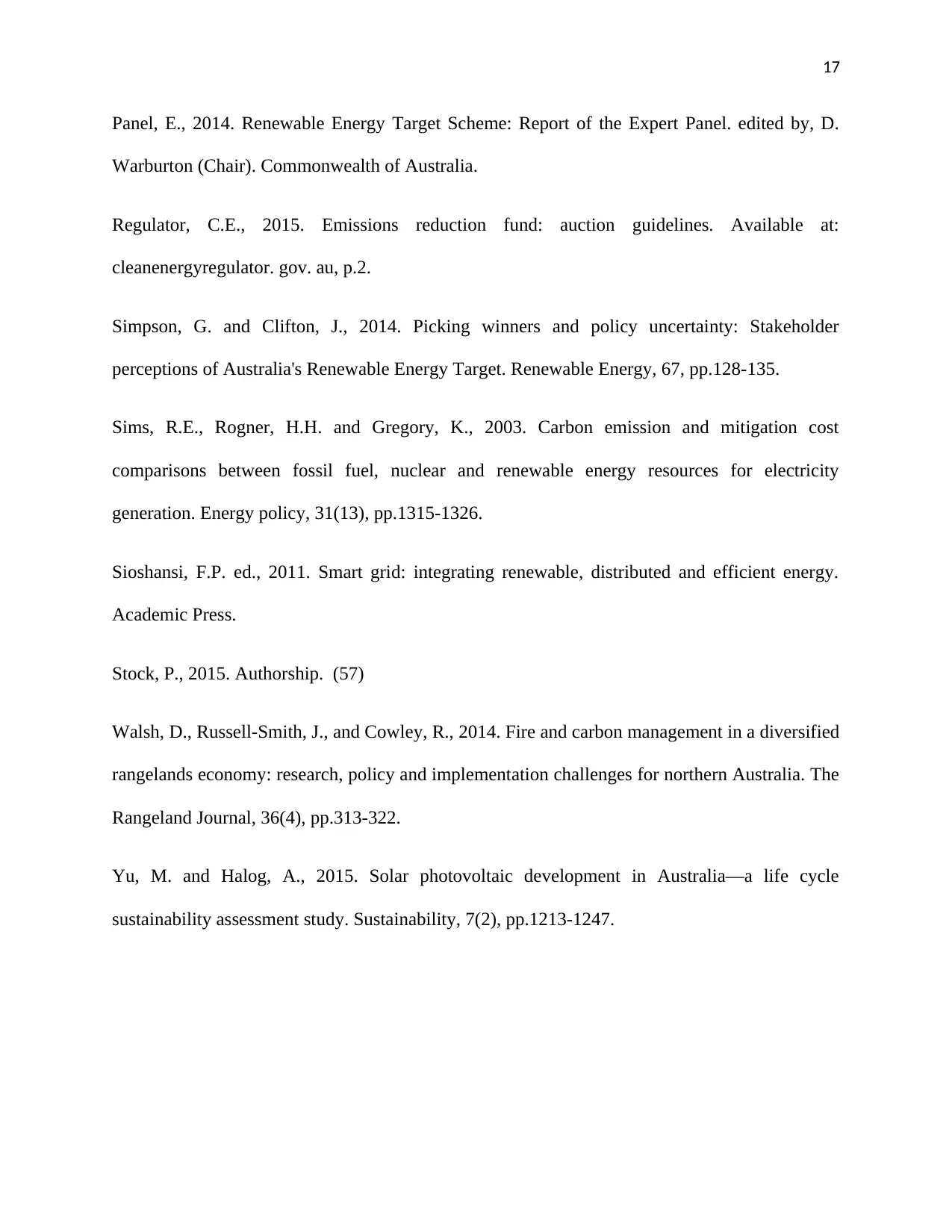
17
Panel, E., 2014. Renewable Energy Target Scheme: Report of the Expert Panel. edited by, D.
Warburton (Chair). Commonwealth of Australia.
Regulator, C.E., 2015. Emissions reduction fund: auction guidelines. Available at:
cleanenergyregulator. gov. au, p.2.
Simpson, G. and Clifton, J., 2014. Picking winners and policy uncertainty: Stakeholder
perceptions of Australia's Renewable Energy Target. Renewable Energy, 67, pp.128-135.
Sims, R.E., Rogner, H.H. and Gregory, K., 2003. Carbon emission and mitigation cost
comparisons between fossil fuel, nuclear and renewable energy resources for electricity
generation. Energy policy, 31(13), pp.1315-1326.
Sioshansi, F.P. ed., 2011. Smart grid: integrating renewable, distributed and efficient energy.
Academic Press.
Stock, P., 2015. Authorship. (57)
Walsh, D., Russell-Smith, J., and Cowley, R., 2014. Fire and carbon management in a diversified
rangelands economy: research, policy and implementation challenges for northern Australia. The
Rangeland Journal, 36(4), pp.313-322.
Yu, M. and Halog, A., 2015. Solar photovoltaic development in Australia—a life cycle
sustainability assessment study. Sustainability, 7(2), pp.1213-1247.
Panel, E., 2014. Renewable Energy Target Scheme: Report of the Expert Panel. edited by, D.
Warburton (Chair). Commonwealth of Australia.
Regulator, C.E., 2015. Emissions reduction fund: auction guidelines. Available at:
cleanenergyregulator. gov. au, p.2.
Simpson, G. and Clifton, J., 2014. Picking winners and policy uncertainty: Stakeholder
perceptions of Australia's Renewable Energy Target. Renewable Energy, 67, pp.128-135.
Sims, R.E., Rogner, H.H. and Gregory, K., 2003. Carbon emission and mitigation cost
comparisons between fossil fuel, nuclear and renewable energy resources for electricity
generation. Energy policy, 31(13), pp.1315-1326.
Sioshansi, F.P. ed., 2011. Smart grid: integrating renewable, distributed and efficient energy.
Academic Press.
Stock, P., 2015. Authorship. (57)
Walsh, D., Russell-Smith, J., and Cowley, R., 2014. Fire and carbon management in a diversified
rangelands economy: research, policy and implementation challenges for northern Australia. The
Rangeland Journal, 36(4), pp.313-322.
Yu, M. and Halog, A., 2015. Solar photovoltaic development in Australia—a life cycle
sustainability assessment study. Sustainability, 7(2), pp.1213-1247.
1 out of 17
Related Documents
Your All-in-One AI-Powered Toolkit for Academic Success.
+13062052269
info@desklib.com
Available 24*7 on WhatsApp / Email
![[object Object]](/_next/static/media/star-bottom.7253800d.svg)
Unlock your academic potential
© 2024 | Zucol Services PVT LTD | All rights reserved.



